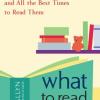 |
What to Read When
An Excerpt
Introduction: The Sound of Reading Calls Us Home
My strongest memory from childhood is the sound of my mother’s voice reading Blueberries for Sal. Little Sal is walking with her pail, and because she is eating so many of the berries, the ones she does manage to save enter her pail with a kerplink, kerplank, kerplunk. I loved the way my mother formed those words as she said them. There was something immensely satisfying in her reading of that book to me. It was a combination of the way she spoke and the nature of the story itself: terrifically scary but at the same time tremendously comforting. One rainy day after school, my mother sat next to me on the couch and read that book to me for probably the hundredth time. I can still remember from that particular day the sound of the rain on the windowpane and the sound of her voice forming the words: kerplink, kerplank, kerplunk. Sal is happily oblivious to the bear cub nearby and yet we know that mother is also nearby. Nothing will happen to Sal. Nothing will happen to the cub. Something in Robert McCloskey’s telling makes you sure.
Years later, it is nighttime, and I am holding one of my daughters, Charlotte, in my arms. She cannot sleep, and so we are sitting together; the chair goes back and forth; her hair smells like milk. We are under the window where the glimmer of a full moon glints down upon us. She reaches her hand up, and it looks to my tired eyes as if she is literally holding the moon inside it. “Good night, moon,” she whispers. She is not yet two. “Good night, room,” I whisper back. “Good night, old lady,” she whispers back to me, and it looks like she winks at me as her hand falls to my shoulder, and she drifts, finally, off to sleep.
The power of reading aloud to draw you and your child near is profound. As Goodnight Moon proves millions of bedtimes over, and as Blueberries for Sal proved unmistakably to me, the sound of the human voice can reach across the gulf of age, of all the things that keep us apart, and create a bridge that lasts a lifetime and extends through generations. Through books and stories that are designed to be read aloud, we convey to our children the beauty of language and the joys of rhythm and rhyme; and in the books we choose to read and the way we read them, we also convey the values we hold dear. Every day as you pack a lunch, wave good-bye to a school bus, tie a shoelace, braid a ponytail, the words you want to say to your child hum inside: I love you, be safe, I love you, be free. I love you, I love you, I love you, let the world treat you kindly, come back to me. Here are the values of my life, our family, here is what I hope for you, here is what I dream for you. And yet, for most of us, too many moments slip by and we’re lucky to get an “I love you” in edgewise. The good news, wondrously, is that the world is full of literature written by people who know you are longing to make connections and are striving to put a voice to them. This book is your guide to making lasting connections with your child through reading. It is also an essential resource for all the best books to read to your child and all the right times to read them.
Children’s literature has long held a cherished place in our culture as a conveyor of values, of belief systems that will give our children courage and help them through a hard day. In Victorian times, children’s books were used to convey a strong sense of morals and discipline. Generations later, writers such as Margaret Wise Brown and Maurice Sendak changed the paradigm of children’s literature by giving voice to the real lives of children, with their many worries and delights. Through these radically new narratives, the “here and now,” as Margaret Wise Brown called them, children were given the opportunity to explore a sometimes confusing universe with a moral compass. How and where will your own child find the human center in an often over-whelming world? Begin the conversation with books that resonate and give you both a point of reference. Whatever the issue at hand—a lost toy, a new sibling, a scary shadow—books and the time spent together reading them can help. There has never been a better time to read aloud to your child. Libraries and bookstores are full of beautiful, astonishing collections that continue to break new ground in their confluence of art and language and depth of feeling. The millions of books available to us also offer an opportunity to redefine childhood in our wired and overprogrammed times, helping us to slow down and reconnect with something timeless and universal. At the same time, the breadth of books with subtle emotion allows us to connect with our children in new and intensely meaningful ways.